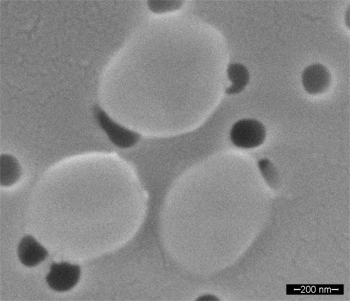| |

SEM image by W.G. Henk and J. Yan, Louisiana State University, Baton Rouge, LA
|
Bioremediation approaches that rely on the action of anaerobic, reductively-dehalogenating bacteria have shown great promise for clean-up of chlorinated solvent-contaminated soil and groundwater. At present, however, the characteristics of bacteria that perform reductive dechlorination, ways to optimize their growth and activity, and tools for monitoring their presence, concentration, and activity remain limited. Dehalogenimonas lykanthroporepellens strain BL-DC-9 is a novel, strictly anaerobic, reductively dechlorinating bacterium that was isolated from groundwater at a superfund site located near Baton Rouge, LA [1] in an area contaminated by high concentrations of several chlorinated alkanes and alkenes [2]. Basic facts about Dehalogenimonas lykanthroporepellens strain BL-DC-9, why it is important, and the motivation behind sequencing are:
1. Dehalogenimonas lykanthroporepellens strain BL-DC-9 displays a unique phenotypic profile. Using H2 as an electron donor, Dehalogenimonas lykanthroporepellens strain BL-DC-9 couples cell growth to reductive dechlorination of 1,2,3-trichloropropane (1,2,3-TCP), a toxic and likely carcinogenic compound. Strain BL-DC-9 also couples cell growth to reductive dihaloelimination reactions involving a variety of other polychlorinated aliphatic alkanes. 1,2-dichloropropane (1,2-DCP) is transformed to propene, 1,2-dichloroethane (1,2-DCA) is transformed to ethene, 1,1,2-trichloroethane (1,1,2-TCA) is transformed to vinyl chloride, 1,1,2,2-TeCA is transformed to a mixture of cis- and trans-dichloroethene (DCE). Unlike some other reductively dehalogenating bacteria, in all of the reductive dechlorination reactions characterized to date, strain BL-DC-9 appears to exclusively utilize vicinally chlorinated alkanes as electron acceptors via dihaloelimination reactions [1, 3].
2. Dehalogenimonas lykanthroporepellens strain BL-DC-9 is phylogenetically unique.Phylogenetically, Dehalogenimonas lykanthroporepellens strain BL-DC-9 lies within a deep branch of the phylum Chloroflexi. It was the first of the reductively dehalogenating Chloroflexi to receive a formal taxonomic description [Moe et al., 2009]. Aside from the closely related strain BL-DC-8 [1, 3], its closest previously cultured phylogenetic relatives are “Dehalococcoides” strains. With 16S rRNA gene sequences sharing only about 90% identity, however, it is distantly related. The similarity of the 16S rRNA gene sequence of strain BL-DC-9 to that of other validly published species is extremely low, approximately 80%. This leaves a tremendous gap in overall analysis of the tree of life and efforts to deduce the evolutionary history and relationship among various taxonomic groups. Sequencing the genome of Dehalogenimonas lykanthroporepellens strain BL-DC-9 will help to fill in these gaps.
3. Relevance to the DOE Mission
Sequencing the genome of Dehalogenimonas lykanthroporepellens strain BL-DC-9 will expand scientific understanding needed to support the incorporation of biological processes into decision making for environmental remediation and/or long-term stewardship, particularly at sites contaminated with chlorinated alkanes. At present, enzymes and metabolic pathways associated with reductive dehalogenation of chlorinated alkanes remain largely unknown, hampering use of DNA-based approaches in decision-making regarding several environmentally important contaminants (e.g., 1,2,3-TCP, 1,2-DCA). Analysis of the complete genome of Dehalogenimonas lykanthroporepellens strain BL-DC-9 will help to elucidate the sequence of putative reductive dehalogenase enzymes and the genes regulating their activity. This will facilitate development of appropriate tools (e.g., primers, probes, microarrays) for monitoring important contaminant transformation processes [4]. More detailed understanding of the metabolic capabilities and activity of chloroalkane-dehalogenating bacteria has the potential to result in better decision making regarding site clean-up at thousands of DOE and non-DOE sites across the US and around the world.
References
[1] Yan, J., B.A. Rash, F.A Rainey, and W.M. Moe (2009) Isolation of novel bacteria within the Chloroflexi capable of reductive dechlorination of 1,2,3-trichloropropane, Environmental Microbiology, 11(4), 833-843.
[2] Bowman, K.S., W.M. Moe, B.A. Rash, H.S. Bae, and F.A. Rainey (2006) Bacterial diversity of an acidic Louisiana groundwater contaminated by DNAPL containing chloroethanes and other solvents, FEMS Microbiology Ecology, 58(1), 120-133.
[3] Moe, W.M., J. Yan, M.F. Nobre M.S. da Costa, and F.A. Rainey (2009) Dehalogenimonas lykanthroporepellens gen. nov., sp. nov., a reductive dehalogenating bacterium isolated from chlorinated solvent contaminated groundwater, International Journal of Systematic and Evolutionary Microbiology, 59(11), 2692-2697.
[4] Yan, J., B.A. Rash, F.A. Rainey, and W.M. Moe (2009) Detection and quantification of Dehalogenimonas and “Dehalococcoides” populations via PCR-based protocols targeting 16S rRNA genes, Applied and Environmental Microbiology, 75(23), 7560-7564. |

